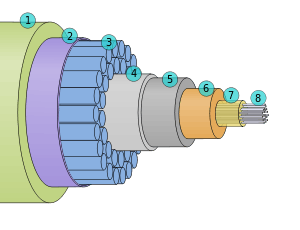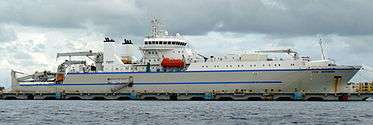International Cable Protection Committee
International Cable Protection Committee |
||||
|---|---|---|---|---|
|
||||
| Motto: Sharing the Seabed in Harmony | ||||
| Headquarters | United Kingdom | |||
| Membership | 157 | |||
| Website www |
||||
Introduction
According to the Reliability of Global Undersea Cable Communications Infrastructure (ROGUCCI) report, nearly 100% of the world’s intercontinental electronic communications traffic is carried by the undersea cable infrastructure.[1] Likewise, submarine power cables underpin the global expansion of offshore renewable energy generation. As such, the impact of failures of these critical telecommunications and power cables can be devastating to social and economic stability. This is why submarine cables are classified as “critical infrastructure” that is to be protected from physical damage due to manmade or natural causes.[2]

2 – Mylar tape
3 – Stranded steel wires
4 – Aluminium water barrier
5 – Polycarbonate
6 – Copper or aluminium tube
7 – Petroleum jelly
8 – Optical fibers
History
The Cable Damage Committee was established on May 22, 1958. The name of the committee was later changed to the International Cable Protection Committee (ICPC) in 1967 to better reflect that intended aims of the organization and its membership.[3] The original organization was for the "Main Committee", as it was originally known, to formulate the policies, which a small Sub-Committee of members, voted in at each Main Committee meeting. Adopted policies were then organized and subsequently implemented. In addition, the Sub-Committee ran the internal administration of the organization through the Secretary.
In the early years, the Sub-Committee would meet frequently, organizing many aspects, such as Cable Warning Charts, which were later devolved down to the organization of individual members. Most of the detailed notes from these early meetings have disappeared prior to 1975, but they always produced a formal report to the Main Committee. The frequency of the meetings prevents their listing prior to the formation of the Executive Committee in 1977.
The title "Plenary" for the Main Committee first appeared in 1972, but would not appear to have been a firm change, but rather a title that evolved gradually during the 1970s. By contrast, the title "Executive" for the Sub-Committee was a firm decision of the 1977 Plenary meeting.
The offices of Chairman and Vice Chairman have been held by the member administration rather than the individual person. This enables a reorganization of staff to take place within an administration, without effecting the Committee's organization. Before 1976 there was no Vice Chairman, and if the administration holding the Chair was unable to attend, as occurred twice, then a Chairman had to be nominated at the start of the meeting. After 1976 the absence of the Chairman was more smoothly covered, as occurred in 1979 and 1991.
The Secretary was initially provided by Cable & Wireless, and subsequently changed to the British Post Office in 1960, although for a number of years after that, the official address remained with Cable & Wireless. The Secretariat remained with BPO/British Telecom International continuously until 1990, when an independent Secretary was engaged. This was followed later by appointment of an International Cable Legal Advisor (1999) and Marine Environmental Advisor (2003).
Presently, governance is exercised by the ICPC Limited, which operates through a 17-member Executive Committee elected by the ICPC membership. ICPC membership has expanded and since 2011, national governments have been allowed to join as a government member in its own right. Government members include the Australia, Malta, New Zealand, Singapore, and the United Kingdom. Since February 2013, Associate membership has been made available to any person or group that shares the goals of the ICPC.
Activities
The primary activities of the ICPC are related to promoting the awareness of submarine cables, both telecom and power, as critical infrastructure that must be protected, – particularly to other seabed users, governments, and the public by establishing internationally agreed upon standards for cable installation, protection, and maintenance. The ICPC actively monitors the evolution of international treaties and national legislation and help to ensure that submarine cable interests are fully understood and protected by all relevant stakeholders. ICPC supports peer-reviewed research into the interactions of cables with the ocean environment to provide an evidence-based foundation for those interactions.[4]
Membership
As of October 2016, the ICPC had 157 members from 60 countries. The membership includes cable owners, operators and manufacturers as well as survey companies, research groups and national governments.
Response to Change
Numerous changes and associated challenges that affect submarine cables are actively studied and addressed by the ICPC membership through the development of industry recommendations. These recommendations contain the combined knowledge of the ICPC membership such that submarine cables are best protected thus ensuring the utmost in reliability of this critical undersea infrastructure. Some of the changes that are actively monitored by the ICPC are summarized below.
- Rapid development of offshore renewable energy
- Increased incidence of damage caused by shipping
- Seabed becoming crowded in some areas
- Environment responses to climate change particularly regarding natural hazards [3]
- Need to maintain harmony with other seabed users
- Need to ensure harmony with seabed environment [2]
- Need to improve security of submarine cables
Industry Recommendations Development
The ICPC develops and maintains a suite of industry standards targeted at the various lifespan stages of undersea cables, from conception to retirement. These standards are available to organizations involved with these various stages through ICPC membership.

- Route planning
- Installation
- Operation
- Maintenance
- Protection
- Out of Service
Educational Resources
The ICPC provides educational materials for the benefit of those who need to be informed about submarine cables and their role as critical infrastructure.[2][3] These materials are intended to promote the awareness of the strategic, socio-economic, and social benefits of submarine cables, especially to government agencies, the fishing industry, other seabed users and the public. Relevant information is also provided to prospective new submarine cable owners to encourage the adoption of minimum industry standards for the benefit of all involved with the seabed. The ICPC has also entered into memorandums of understanding with the International Seabed Authority and the Rhodes Academy to further cooperation with these two bodies. The ICPC also has a working relationship with the East-West Institute.
Information Sharing
The ICPC provides a forum for members to interact and learn about legal, technical, and environmental developments relevant to submarine cables where areas of common interest are identified such that members can benefit from working together and each other’s expertise and real-world experience. To ensure information sharing external to the ICPC, affiliations are also developed with equivalent seabed user organizations the world over. Formal relationships with appropriate international organizations are also developed with the goal of information sharing.
Projects
The ICPC engages in projects that are beneficial to the protection of submarine cable systems. For example, a global database showing fault causes and average repair times is developed and maintained. Research projects associated with the potential effects of submarine cables on the seabed environment are also performed to ensure harmony with the undersea environment.[2]
Law
The ICPC actively monitors the development of international treaties and national legislation to advise and support committee members when changes to laws are proposed that may affect submarine cables. Expertise to ensure ongoing compatibility and uniformity of the law with various industry requirements is also provided through ICPC membership.
Workshops are held by the ICPC with national governments and regional organizations to foster understanding of the rights and obligations that States have with respect to submarine cables under the United Nations Law of the Sea Convention (UNCLOS).
The ICPC sponsors a reference handbook based on unique collaboration of 15 industry experts, scientists, and international law scholars that address critical legal and governance issues, as it pertains to submarine cables deployed around the world.[5]
Environment
The interaction between submarine cables and the marine environment is documented in peer-reviewed, mainstream publications.[2][4][6]<ref =HYPERPYCNAL>R. Gavey, "An Evaluation of Modern Hyperpycnal Processes and their Relevance to the Geological Record, p. 339”, Southampton University, United Kingdom, 2011</ref> The ICPC supports such research as a means of providing evidence-based analyses to assist cable protection in naturally hazardous regions [4] and cable operations in environmentally sensitive areas .
External links
| Wikimedia Commons has media related to Maps of submarine communication cables. |
- TeleGeography Interactive Cable Map Comprehensive online submarine cable map with a wealth of information.
References
- ↑ IEEE, "Reliability of Global Undersea Communications Cable Infrastructure (ROGUCCI) Report, p 33, Issue 1", IEEE, February 2010
- 1 2 3 4 5 Biodiversity Series 31, "Submarine Cables and the Oceans – Connecting the World, p. 64, ISBN 978-0-9563387-2-3", ICPC/UNEP-WCMCJanuary 2009
- 1 2 3 "International Cable Protection Committee (ICPC)"
- 1 2 3 L. Carter, J.D. Milliman, P.J. Talling, R. Gavey, R.B. Wynn, "Near-Synchronous and Delayed Initiation of Long Run-Out Submarine Sediment Flows from a Record-Breaking River Flood, Offshore Taiwan, Geophysical Research Letters, p. 39, L12603, doi: 10.1029/2012GL051172", 2012
- ↑ D.R. Burnett, R.C. Beckman, "Submarine Cables the Handbook of Law and Policy", ICPC and the National University of Singapore – Centre for International Law, 2014
- ↑ M.P. Wood, L. Carter, "Whale Entanglements with Submarine Telecommunication Cables, Issue 33, pp. 445–460", IEEE Journal of Oceanic Engineering'", 2008
